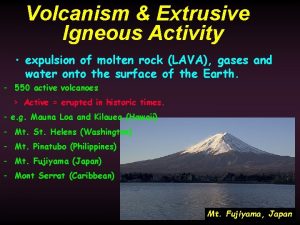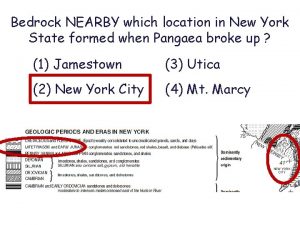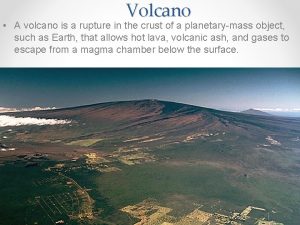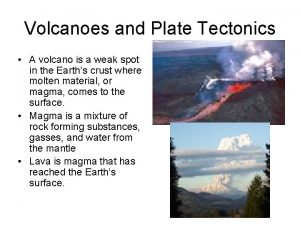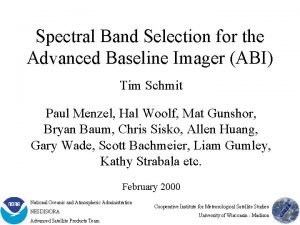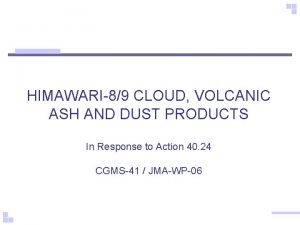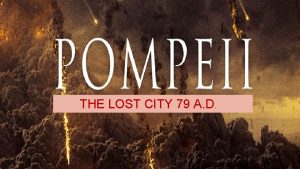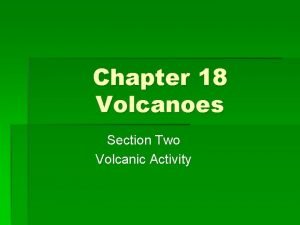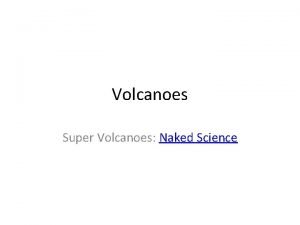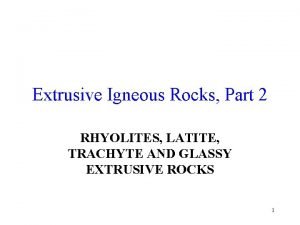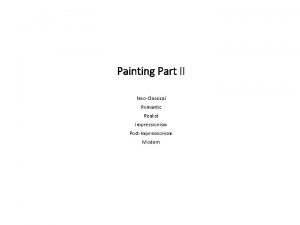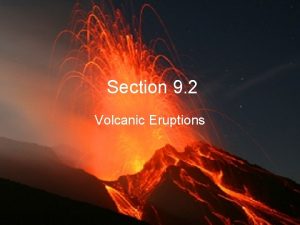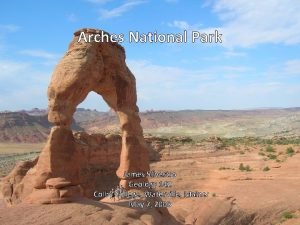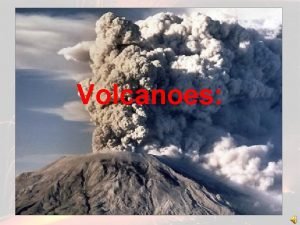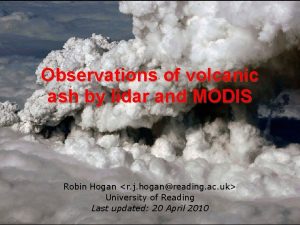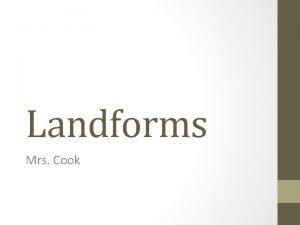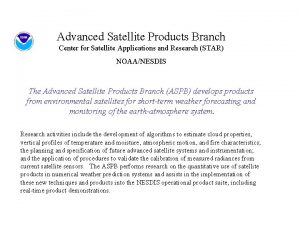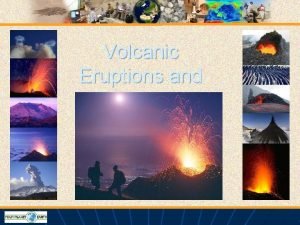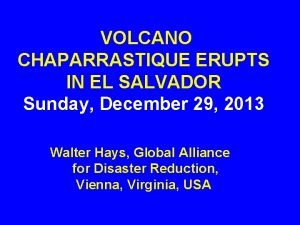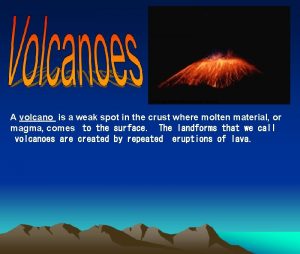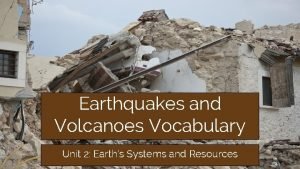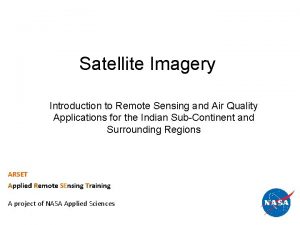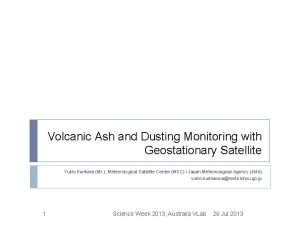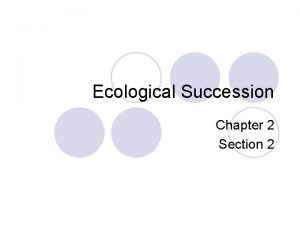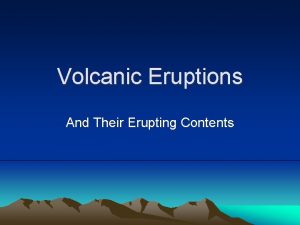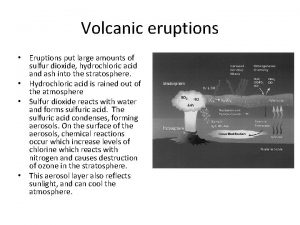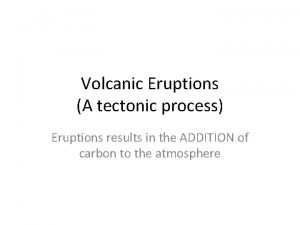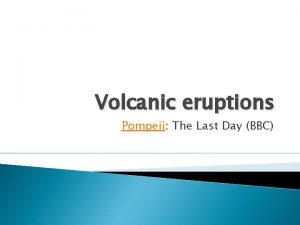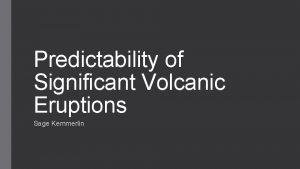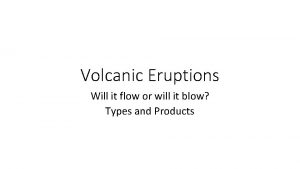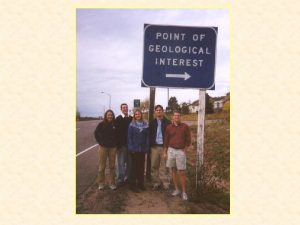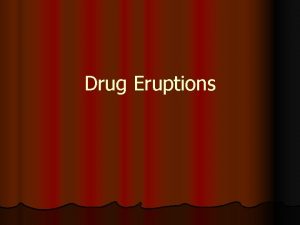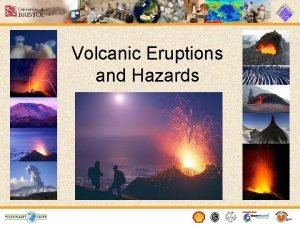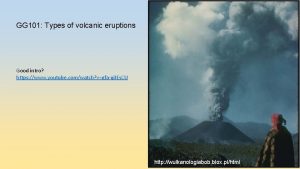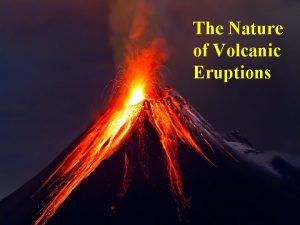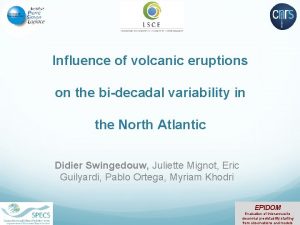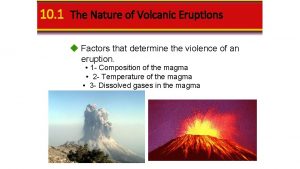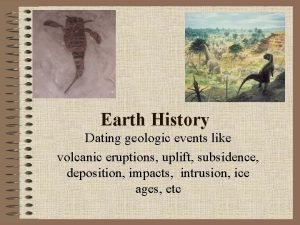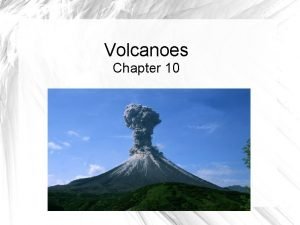Volcanic Eruptions Will it flow or will it






























- Slides: 30

Volcanic Eruptions Will it flow or will it blow? Types and Products

Explosive Eruptions • Less common • More destructive • Mostly produce clouds of hot ash, gas and rock fragments shoot rapidly out of a volcano. • Ash can reach upper atmosphere and stay for years, blocking sunlight • Can blast billions of tons of material • Eg Mount St. Helens

Nonexplosive Eruptions (Effusive) • More common • Less destructive (more time) • Mostly lava flowing over the Earth’s surface • Most rock on ocean floor was produce by nonexplosive eruptions (Oceanic Volcanoes)

Factors Affecting Eruptions The type of eruption is determined by the composition of the magma (what it’s made of): water – more water means less viscous, flows easier gas - more gas, more violent silica - more silica means more viscous, slower flowing

Gases in Magma • Water vapor, Carbon dioxide, Sulfur, Hydrogen • As magma comes to the surface, the gases are released as bubbles, making the eruption more explosive.

Silica Content • Silica is silicon and oxygen. • Magma with low silica contents is thinner, less viscous, allowing gases to escape more easily. • Magma with high silica content is thick and slow-moving

Silica and Gas Content • Silica-rich Magma will flow slowly and may harden inside a volcano’s vents, blocking them. • As more magma pushes up from below, the pressure increases. • Silica-rich magma may be so stiff that water vapor and other gases cannot escape from the magma. • Trapped bubbles of gas may expand until they explode.

Lava Composition

Mafic/Basaltic Lava Flow • Dark in colour due to high iron and magnesium • Low viscosity due to low silica content, • Rapid (up to 100 km/hr), Long distance flow – up to 100 s of km • Form much of ocean crust • Mafic magma allows gases to escape more easily, resulting in less explosive eruptions. • (P and a’a)

Intermediate/Andesitic Lava Flows • Intermediate to high viscosity (more Silicon than basalt) moderate amounts of silica, Fe and Mg • Mound near vent, flow slowly • Outer crust fractures, creating rubble

Felsic or Rhyolitic Lava Flows • Highest silica content, most viscous • Low iron, and magnesium • Rarely flows • Plugs vent as a lava dome • Lower temperature • gases do not escape easily, leading to more explosive eruptions. • Common in continental crust

Eruptive Material Lava Flows, Pyroclastic debris, volcanic gases


Types of Lava Flows • Geologists classify lava by the shapes it forms when it cools. • There are two major types of basaltic lava flow: a'a and pahoehoe.

Pahoehoe • Pahoehoe lava, is fastflowing and runny. • forms smooth, “ropey” masses.

A’a lava • A’a lava has a rough jagged surface, • formed when slow-moving, sticky lava cools and breaks up into sharp, blocky shapes. • More common

Blocky Lava • Blocky lava is cool, stiff lava that does not travel very far from the volcano forms piles of rocks with sharp edges. • Larger blocks than aa lava, and have smoother surface

Pillow Lava • Forms when lava flows out of the Earth’s crust underwater. • As it cools, it forms rounded lumps that look like pillows.

Types of Pyroclastic Material Pyroclastic materials are individual eruptive(solid) fragments are called pyroclasts (“fire fragments”).

Tephra (Greek for “ash”) • Tephra (Greek, for ash) is the generic term for any airborne pyroclastic material • Classified according to size • Heaviest particles settle out first

Volcanic Ash • fine-grained fragments < 2 mm in diameter • Volcanic ash forms when gases trapped in magma or lava form bubbles. • When the bubbles explode, they create millions of tiny pieces.

Volcanic Ash on Plymouth, Monserrat after 1995 Eruption

Lapilli (Latin for “little stones) Lapilli are small bits of lava that harden before they hit the ground. Pea- to walnut-size pyroclasts (2 -64 mm) All types of lava produces lapilli. All types of volcanoes produce lapilli

Lava Bombs • Lava bombs are large (< 64 mm) blobs of ejected while still molten, gaining a streamline shape, harden in the air and cool before they reach the ground.

Lava Blocks • Angular fragments ejected in solid condition. • larger than 64 mm in diameter • Can be as big as houses

Pyroclastic Flows • Very hot (700ºC), Very fast (100 km/h), current of gas and tephra. Capable of reaching 700 km/h • Very dangerous (can destroy everything in its path). • A pyroclastic flow from the eruption of Mount Pinatubo is shown in the figure below. • https: //www. youtube. com/watch? v=EZd. Fqvnz. Cl. U • Play only 1 st minute

Other weird Tephra: Pele’s Tears • lapilli-size fragments of basaltic lava may cool quickly while airborne, to form glassy teardrop-shaped lapilli

Pele’s Hair • During strong winds, these molten fragments can be drawn out into fine filaments

Homework • Volcano WS, Questions #1 -7 • Research a Volcano Assignment

Volcano Research Assignment: Showcase a volcano from the list or one of your choice • Name of volcano, location, date of last eruption • Type of volcano • Type of eruption (explosive/ effusive) • Type of eruptive material • Consequences/damage/death toll • Images (before, during, and after eruption)
 Clastic vs non clastic
Clastic vs non clastic Process of volcanic eruption
Process of volcanic eruption Stratovolcano plate boundary
Stratovolcano plate boundary Thin layers of volcanic ash act as excellent time markers
Thin layers of volcanic ash act as excellent time markers Volcanic rupture
Volcanic rupture Volcanic belts form along the boundaries of earth's
Volcanic belts form along the boundaries of earth's A whale bone that originally contained 200 grams
A whale bone that originally contained 200 grams Volcanic ash
Volcanic ash Volcanic ash
Volcanic ash Rhyolite lame mince
Rhyolite lame mince Volcanic ash
Volcanic ash Chapter 18 volcanic activity
Chapter 18 volcanic activity Cinder cone volcano
Cinder cone volcano Rhyolite
Rhyolite Volcanic ash
Volcanic ash Volcanic landform
Volcanic landform Batholith
Batholith Lava plateau diagram
Lava plateau diagram Arch
Arch Volcanic landform
Volcanic landform Volcanic ash
Volcanic ash Volcanic landform
Volcanic landform Volcanic ash
Volcanic ash Volcanic landform
Volcanic landform Volcanic ash
Volcanic ash Volcanic ash
Volcanic ash Volcanic island arc
Volcanic island arc Volcanic ash
Volcanic ash Volcanic ash
Volcanic ash Convergent plates
Convergent plates After a volcanic eruption lava covers the land
After a volcanic eruption lava covers the land


